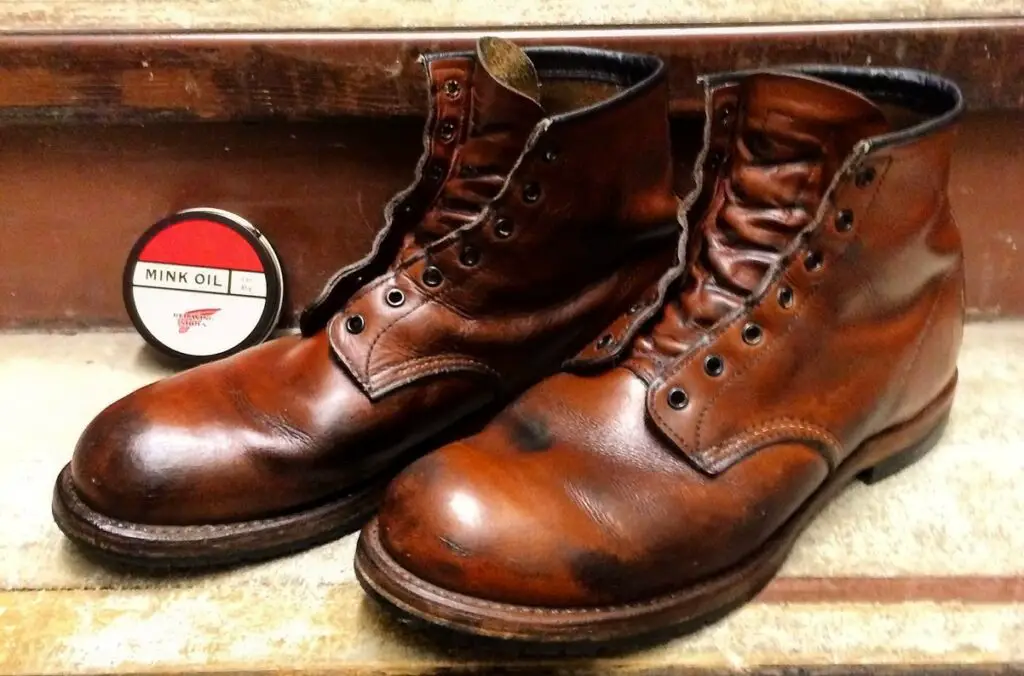If you have a pair of leather boots, you probably know you can use mink oil for your boots. Mink oil is a kind of oil produced from mink. It has conditioning features that can soften leather very well. So, people have been using mink oils for decades as a treatment for their leather shoes.
 Mink oil is extracted from the fatty layer of the mink’s abdomen. Thus, it is rich in fatty acids, unlike any other oil. Moreover, it won’t go rancid as fatty acids don’t react with oxygen. This makes the shelf life of mink oil longer than other animal oils.
Mink oil is extracted from the fatty layer of the mink’s abdomen. Thus, it is rich in fatty acids, unlike any other oil. Moreover, it won’t go rancid as fatty acids don’t react with oxygen. This makes the shelf life of mink oil longer than other animal oils.
Using mink oil inside boots is good in the short term as it conditions the inner layer. However, in the long term, mink oil has negative effects as speeding the wear out of the boots. So, it depends on the frequency of using mink oil. Also, the amount of oil applied inside the boots matters.
Advantages and Disadvantages of Mink Oil Inside Leather Boots
Mink oil has several advantages inside the boots. However, each of these advantages can have negative consequences if not applied in the right way.
Leather conditioning
Starting with the conditioning feature, mink oil can soften the leather. By applying a generous amount of oil to the boots, you can make stiff boots softer and easier to wear. As most leather boots’ owners know, leather is flexible and forms to the feet. Conditioning the leather makes it softer and faster to form around the feet. That’s why some people may use mink oil inside their boots.
To get the intended results, you should leave the boots an adequate time to completely absorb the oil. The oil will penetrate the leather pores filling them and thus, softening the fibers within. Yet, you must remove any excess oil as it might lead to leather rottenness.
On the other side, while mink oil will make the boots softer, it is hard to remove excess oil from the inside. Excess oil inside may lead to rottenness. Also, too much softness inside the boots can make them wear faster.
Water-resistant layer
The coat that mink oil creates by filling the pores will block any moisture. Mink oil is a thick oil that can resist water, thus, protecting the boots from moisture. Whenever water leaks into the inside of your boots, leather won’t get affected as it has a waterproof layer.
Yet, excessive oil on leather lock the moisture inside the pores and this leads to rottenness. So, an adequate amount of mink oil protects leather against water whereas too much oil damages it.
Mostly, people are not too much into protecting the inside of their boots from water. This is simply because this inner side is not normally subjected to water like the outer parts.
See Also: Best oil for work boots
Pro Tips for Applying Mink Oil inside Boots
So, as you can see, mink oil has a great advantage over leather boots. Furthermore, you can use it on any leather shoes. This includes oil-tanned boots and smooth-finished ones. However, you should be careful with the following points.
Leave your boots in the sun for an hour or two after oil application. This helps the leather to absorb the oil quickly. If you don’t live in a place where the sun heat is available, you can use a hairdryer.
Use a dry piece of cloth to remove excess oil from inside the boots. Also, it is better to use a brush when applying the oil instead of just pouring some oil. This offers better distribution on the inner side and won’t leave too much excess oil.
Many people have always complained that mink oil changed the color of their leather shoes. So, when applying oil inside, make sure you don’t leave any excess oil on the upper parts of the boots. Unless you don’t mind a degree or two darker color tones, never put mink oil on the outer parts.
Another important consideration is mink oil on the outsoles. Mink oil will make soles softer and thus, they will wear out quickly. Also, the lower part of the shoes will become sticky and will collect dirt. So, ensure the oil never reaches the outsoles.
Conclusion
Mink oil is a favorite for many leather boots’ owners. Its conditioning feature is superior to any other alternatives. Whether you apply it to the outer sides of the boots or inside them, don’t overdo it.
For application inside the boots, you should have a reason to do so. Unless you need to soften the leather inside, no need to apply oil regularly.







